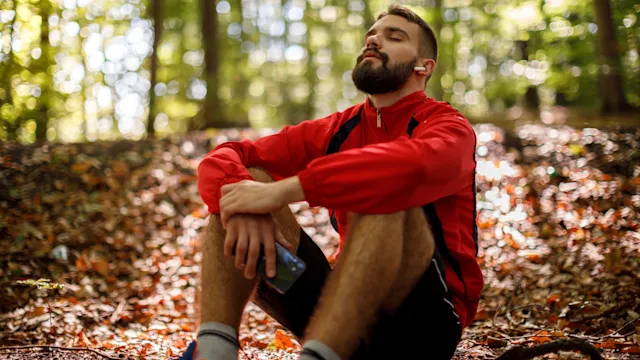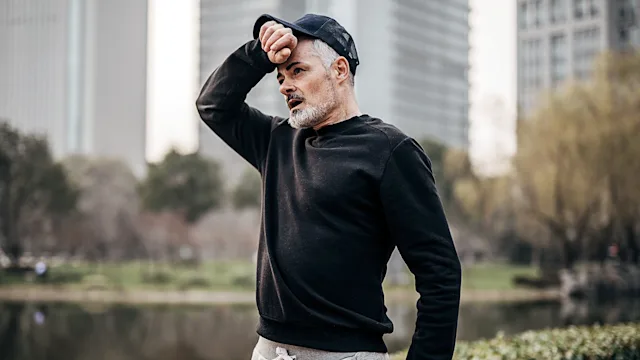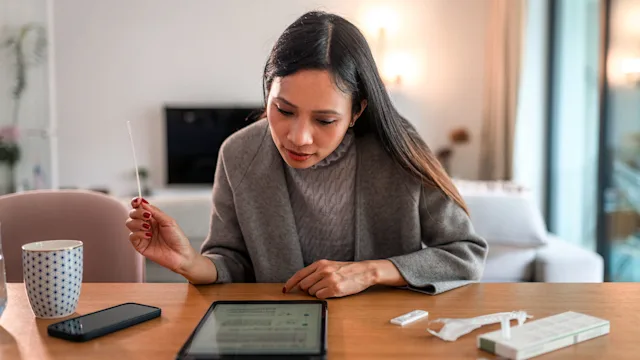Key takeaways:
People who have low oxygen levels and need oxygen therapy can have a hard time getting out of the house.
A portable oxygen concentrator (POC) is a convenient way to use oxygen outside of the home.
Though POCs can be expensive, insurance coverage and financial assistance programs can make them more affordable.
If you’re using home oxygen, you know it can help you feel better and be more active. Even though home oxygen is easy to use, oxygen canisters and home concentrators are often large and heavy. This means it’s not really a treatment that you can use on the go. Many people who use home oxygen end up feeling socially isolated. They may miss out on travel, family events, and work opportunities.
But, if you’re among the 1.5 million people in the U.S. who use oxygen, there’s a smaller, more lightweight option that could help you get out more often. It’s called a portable oxygen concentrator (POC). A POC can go just about anywhere you go — whether that’s the grocery store, the movies, a baseball game, or a picnic.
Though they can be expensive, POCs can help you live a full life while also getting the oxygen your body needs.
How do portable oxygen concentrators work?
POCs work by taking the air around you and turning it into pure, fresh oxygen. The oxygen then travels through a small tube to your nose. This delivers oxygen into your body with every breath, helping you to feel better physically.
Some POCs deliver a steady stream of oxygen (continuous flow). Others deliver oxygen in short bursts every time you inhale (pulse flow). Many POCs can deliver both types, too.
What are the benefits of portable oxygen concentrators?
For many people, using an oxygen tank or home oxygen concentrator works just fine. But there are a couple of benefits to using a POC:
It’s portable. POCs are smaller and more lightweight than oxygen tanks or home oxygen concentrators. This makes them easier to take with you outside of the home.
You won’t need to buy oxygen refills. You don’t need to refill POCs with oxygen. The machine pulls all the oxygen it needs from the air around you. Some people find this more convenient than a classic oxygen tank.
But keep this in mind: POCs do run on a rechargeable battery. Most batteries last for several hours, but it depends on what type of machine you have and how fast you’re breathing. Once the battery runs out, you’ll either have to recharge it or use a spare battery before you can get your oxygen again.
The best portable oxygen machines
According to the American Lung Association, it’s best to look for a POC that’s FDA approved. There isn’t a “best” machine, since the most important factor — whether it can deliver the right amount of oxygen for you — isn’t the same for everyone.
When choosing a POC, different features to consider include:
Type of oxygen flow (continuous, pulsed, or both)
Oxygen concentration and capacity
Number of flow settings
Noise level
Battery life
Size and weight
Ease of carrying (curved design or attached strap)
Approval for air travel by the Federal Aviation Administration (FAA)
What’s it like to use portable oxygen? Oxygen users and a respiratory therapist describe what to expect when using portable oxygen.
The price of portable oxygen: How much portable oxygen costs depends on many factors. Our experts break down what you need to know before purchasing.
Pulmonary rehabilitation programs: People with chronic breathing problems may benefit from pulmonary rehabilitation. Learn about the benefits and what it involves.
The National Council on Aging has researched many machines, and they have a list of top picks for POCs based on price, weight, battery life, and more. Here are some popular options.
CAIRE Freestyle Comfort
The CAIRE Freestyle Comfort weighs about 5 lbs and offers up to 16 hours of battery life. It can automatically change the flow based on your breathing rate. In reviews, users say that they appreciate the company’s customer support and product warranties.
Inogen Rove 6 (formerly One G5)
The Inogen Rove 6 model weighs less than 5 lbs and is relatively quiet. It gives you the ability to use a double battery, which extends battery life (up to 13 hours). It also connects to an app, which allows you to monitor battery life, change settings, and connect to customer support, if needed.
Read more like this
Explore these related articles, suggested for readers like you.
Oxlife Liberty2
The Oxlife Liberty2 machine can provide higher continuous (up to 2 L) and pulse oxygen flows (with 9 settings) than most. It weighs about 6 lbs, and it’s pricier than other models.
PrecisionMedical’s Live Active Five
PrecisionMedical’s Live Active Five model has a dual curve design for carrying on either side of your body. And you can access the battery from the top, so there’s no need to take it out of the bag. It weighs 5 lbs and has 5 pulse settings.
Note: GoodRx hasn’t tested these devices and therefore can’t make recommendations. And, this isn’t a comprehensive list. If you have questions about how to choose a safe and effective POC, contact the American Lung Association. They have a telephone helpline that you can call for advice at 1-800-LUNG-USA (1-800-586-4872), or you can submit a question online.
How much do portable oxygen concentrators cost?
Portable oxygen concentrators are pretty expensive — usually upwards of $2,000. The price varies depending on the model and features. But, if you meet certain requirements, your health insurance might cover part of the cost.
Here are some tips for paying for your portable oxygen concentrator:
Talk with your insurance company. Ask your insurance company if they cover POCs. Starting here allows you to see what options are available under your plan.
Set up a payment plan. Some POC vendors offer payment plans, so the cost is spread out over many months or years.
Apply for financial assistance. Need-based financial assistance programs are available to help you afford your medical treatment — including prescriptions, medical equipment, like POCs, and other expenses.
Consider renting. If you only need a POC for a specific event or a short period of time (like a wedding or a vacation), short-term rentals are available.
Consider the X-PLOR portable oxygen concentrator. This X-PLOR is a POC that’s available to GoodRx users at a discounted rate.
How to use portable oxygen
All portable oxygen machines are different, so make sure to learn how to operate yours. If you have questions, check the user manual or contact the manufacturer’s customer support department.
Once you understand how your particular machine works, here are the basics:
Connect the nasal tube to the machine, and turn on the device.
Make sure you have enough battery life remaining.
Set the oxygen flow to the rate prescribed by a healthcare professional.
Once the oxygen is flowing, put the nasal tube on your face.
Remember, using oxygen can cause fires. Stay safe, and never use your portable oxygen near an open flame or while smoking.
How do you get a portable oxygen concentrator?
First, get a prescription from a healthcare professional.
Once you have a prescription, you’ll need to find a medical equipment supplier. You can find one online or go to a local store.
When to talk to your doctor about oxygen therapy
Having a low oxygen level can cause many different symptoms. Talk with your healthcare team if you have a lung condition, such as chronic obstructive pulmonary disease (COPD), and you’re experiencing the following symptoms:
Tiredness
Shortness of breath
Memory and concentration problems
Confusion or “brain fog”
Coughing and wheezing
Headache
Rapid heart rate
Bluish color in your skin, fingernails, and lips
If your healthcare team is worried about your oxygen levels, they might suggest some additional tests, including:
Spirometry: This test measures how well you can breathe air out of your lungs.
Pulse oximetry: This device uses a sensor that attaches to your finger and measures your blood oxygen levels.
Treadmill test: This test measures how your breathing and oxygen levels change when you’re physically active.
These tests can help your healthcare team decide whether you need additional oxygen and, if so, how much. Some people just need oxygen at certain times or in certain situations. Other people need to use it all the time.
Frequently asked questions
Medicare and Medicare Advantage typically cover much of the cost. After you’ve met your deductible with Part B, you’ll be responsible for 20%.
No, you can’t get a portable oxygen machine without seeing a healthcare professional. Genuine portable oxygen concentrators are only available with a prescription.
Though you might see POCs for sale without a prescription, the American Lung Association warns against using them. These are often cheaper, but not cleared by the FDA. They also don’t work very well and won’t deliver the right amount of oxygen to your lungs and body.
How long a portable oxygen tank will last depends on your oxygen needs and the size of the tank. The regulator on the tank will indicate how much oxygen is left in the tank, so be sure to keep an eye on it.
The time limit on a POC, however, depends on the battery life. And the battery life depends on your flow rate and breathing rate.
Medicare and Medicare Advantage typically cover much of the cost. After you’ve met your deductible with Part B, you’ll be responsible for 20%.
No, you can’t get a portable oxygen machine without seeing a healthcare professional. Genuine portable oxygen concentrators are only available with a prescription.
Though you might see POCs for sale without a prescription, the American Lung Association warns against using them. These are often cheaper, but not cleared by the FDA. They also don’t work very well and won’t deliver the right amount of oxygen to your lungs and body.
How long a portable oxygen tank will last depends on your oxygen needs and the size of the tank. The regulator on the tank will indicate how much oxygen is left in the tank, so be sure to keep an eye on it.
The time limit on a POC, however, depends on the battery life. And the battery life depends on your flow rate and breathing rate.
The bottom line
If you need oxygen, there are many options — including a portable oxygen concentrator (POC). POCs are lightweight and easy to take with you on the go. And being able to take your oxygen with you means that you can get the treatment you need, while also being able to do more activities that you enjoy.
If you’re considering a POC, talk with your healthcare team. They can help you understand the options and work with your insurance company to get coverage. They can also help you understand how to correctly use your machine, including how much oxygen you should be using for maximum health benefits.

Why trust our experts?



References
American Lung Association. (2023). Oxygen therapy: Getting started with a portable oxygen concentrator.
American Lung Association. (2024). Oxygen therapy: Getting started with oxygen in metal tanks.
American Lung Association. (2025). Financial assistance plans: Where to get help paying for medical treatment.
American Lung Association. (2025). Lung helpline – How can we help you?
Casaburi, R., et al. (2023). Evaluation of over-the-counter portable oxygen concentrators utilizing a metabolic simulator. Respiratory Care.
Chronic Obstructive Pulmonary Disease Foundation. (2018). Playing with fire – Staying safe using home oxygen therapy.
Currie, D. (2024). 9 best portable oxygen concentrators of 2025: Our expert picks. National Council on Aging.
Federal Aviation Administration. (2021). Acceptance criteria for portable oxygen concentrators.
Jacobs, S. S., et al. (2021). Patients choose hypoxemia over social isolation. Annals of the American Thoracic Society.
New York State Office of Fire Prevention and Control. (n.d.). Home oxygen fire safety.















